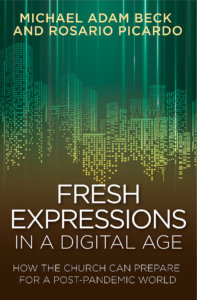New preaching strategies are needed to engage emerging generations in the digital age. Michael Beck and Rosario Picardo say sermons in the post-pandemic church will likely be shorter, more conversational and interactive, and less reliant on a single voice.
One major gift the pandemic provided was an opportunity to rethink the preparation and delivery of sermons. In Protestant churches the sermon is a central component of the worship service. Over half of a one-hour service is dedicated to the reading of Scripture, the proclamation of the sermon, and an opportunity for hearers to respond in some way. But in the digital space, even the most gifted orators across the country noticed that viewership was decreasing during the sermon time.
Unfortunately, one of the side effects of long-term engagement with electronic media is a diminished capacity for long-term sustained attention. Preachers are familiar with a well-known saying, “the mind can only take what the butt can stand.” We can rephrase this for the online culture, “the mind can only receive what can be stimulated through the screen.” In the digital medium, we need to think about the people on the other side of the screen and their experience.
From monologue to dialogue
In the pandemic, when we all had to figure out how to do online church, there was a sharp learning curve. Many clergy discovered they had to learn an entirely new skill set, moving from well-polished, staged, propositional monologues to facilitating dialogical conversations. Emerging generations have been disconnected from the idea of being “preached to” for decades. Many preachers discovered in the isolation of quarantine that people yearned to be heard and known. They began experimenting with ways to facilitate this through online worship. In a post-Christian, networked society, the sermon is present, but it takes a different form.
Sermonic conversations
In most fresh expressions of church, there’s not a formal moment when the religious professional stands up to tell us what the Bible means and how to apply it personally. Rather, there’s a conversation around a “Jesus story” or a few verses of biblical text. Someone frames the text or story, provides a little background, and then asks open-ended, nonconfrontational questions.
The art of sermonic conversation is not a new phenomenon. It was in fact the preferred method of Jesus’s teaching. Jesus’s favorite teaching approach was to ask questions. Jesus secured attention first because he was an interesting person doing interesting things but secondly because he knows how to get people’s attention. In Jesus, The Master Teacher, Herman Horne writes, “Jesus received attention because he paid attention. He saw and was interested in what people were doing and saying, and in their needs, and in helpful sympathy he drew his soul out unto them. His works prepared the way for his works.”
Sermonic conversations, like a well-formed lectio divina class, can be deeply transformative for the community. We start with a biblical text, we engage the text together, we locate ourselves in the story or epistle or poetry, and finally wrestle with the implications for our lives.
The power of questions
Asking questions was the primary way that Jesus established a point of contact to engage the attention of his hearers. Jesus used his parabolic questions as a rhetorical device to keep the listener’s attention. He was creating points of contact for listeners to be heard, locating themselves in the parables. These story-based questions were an intimate connection to the hearers.
One of the keys to engagement is crafting questions that don’t have a right or wrong answer but plug into the postmodern tendency to share from personal experience. That doesn’t mean there’s no right or wrong behaviors, but people should come to those realizations themselves. Actually, the Bible itself does the heavy lifting, not our forceful oratorical flourishes.
When we examine the teachings of Jesus in this way, we see where some approaches to preaching don’t connect with people not yet in church. Most sermons are a biblical exegesis to help the congregation understand and respond to the guidance of scripture. This doesn’t work well if it is a conversation between the text and the preacher.
Multiple voices
In a digital culture with values like sharing, crowdsourcing, and remixing, we need to think of every gathering as a team event. This is even true of sermons. The best communicators help everyone involved shine for the good of the show. In a digital medium the brain craves variety, at the risk of distraction. The brain won’t stay engaged on anything that’s boring. No single communicator can hold an audience’s full attention for long periods of time, no matter how skilled. However, there are ways to introduce variety into a presentation that sustains the attention of the brain.
The tactic of using guest speakers is very important for effective sermonic conversations. So, guess who the guests are? They are mostly or typically the people within the gathered community. Just as Jesus invited people into his teaching with questions, we can grab the attention of our hearers by inviting them into the conversation and really listening to what they are saying whether it is spoken out in digital space or in a chat.
As people scroll through their social media feeds and suddenly find themselves in our “worship experience,” we have a very small window of opportunity to engage them in a way that connects. The robed professional standing in the empty sanctuary, delivering a theological treatise (usually written out on manuscript or teleprompter) is the wrong approach. Missional practitioners have discovered that presenting Jesus and asking questions seems to be the most appropriate way to engage new people on the digital frontier.
 This article is taken from Fresh Expressions in a Digital Age (Abingdon Press, 2021) by Michael Adam Beck and Rosario Picardo. Used by permission. The book is available at Cokesbury and Amazon.
This article is taken from Fresh Expressions in a Digital Age (Abingdon Press, 2021) by Michael Adam Beck and Rosario Picardo. Used by permission. The book is available at Cokesbury and Amazon.
Related Resources
- “Imagining a Hybrid Future,” a Leading Ideas Talks podcast episode featuring Rosario Picardo
- What Approach to Digital Worship is Best for Your Church? by Tim Snyder
- There’s No Going Back to the Pre-Pandemic Church by Kay Kotan






